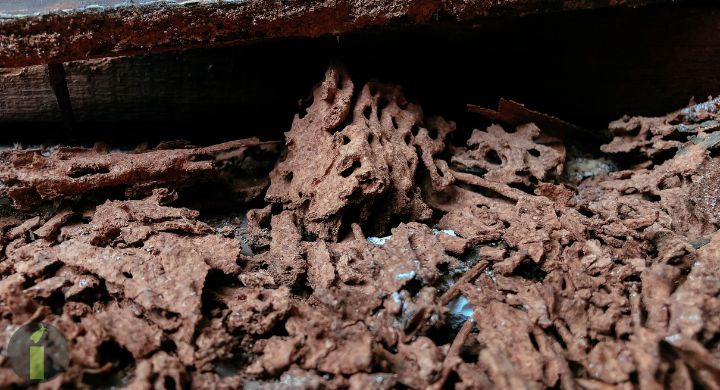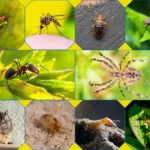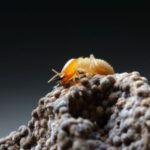Termite Holes
Termites make holes in the wood or other materials they infest, known as “termite holes.” Termites are insects that consume materials made of cellulose, such as paper, wood, and some types of cloth. They can potentially seriously harm structures if not controlled.
In this article, we will discuss the appearance of termite holes, their location, and different termite species. We will also discuss what damage termites cause, how to detect their presence, and treatment of termites. So let’s explore more about termite holes

Table of contents
- Termite Holes
- Appearance of Termite Holes
- Location of Termite Holes
- Termite Species
- Damage caused by Termites
- Surface Damage
- Inspection of Termite Holes
- Visual Inspection
- Use a Flashlight
- Tap and Listen
- Look for Mud Tubes
- Examine Fecal Pellets
- Check for Discarded Wings
- Seek Professional Inspection
- Professional Inspection
- Identification of Entry Points
- Treatment Methods
- Localized Treatments
- Monitoring and Follow-Up
- Wood Replacement and Repairs
- Preventive Measures
- Frequently Asked Questions (FAQs) about Termite Holes
Appearance of Termite Holes
Termite holes can look different depending on the termite species and infestation stage. The following are some typical traits linked to the development of termite holes:

Size
Depending on the type of termite and the age of the colony, termite holes can range in size from tiny pinholes to larger holes. Other variables that may affect the size include the kind of wood that is infested.

Shape
Termite mounds frequently have asymmetrical shapes. They could have the appearance of tiny, rounded apertures, or they could be longer and resemble galleries or tunnels. Termites’ tunneling through the wood affects the shape.

Location
Usually, the surface of infested wood has termite holes. Termites feed on cellulose-based materials, such as furniture, wooden structures, and other materials that are visible on the outside.

Surrounding Evidence
Apart from the holes, additional indications of termite activity might be nearby. This could include termite feces pellets, mud tubes made by subterranean termites, abandoned swarmer wings, or damaged wood that resembles honeycombs.

Mud Tubes
When subterranean termites travel from their nest to a food source, they frequently construct mud tubes to protect them. One standard indicator of underground termite activity is the presence of mud tubes next to or beside termite holes.

Fecal Pallets
Fecal pellets that dry wood termites expel from their galleries may gather close to termite holes. The shots are hard, small, and come in various colors; they frequently resemble sawdust or sand grains.

Location of Termite Holes
Termite species and the particulars of the infestation can affect where termite holes are found. Here are some general pointers regarding potential termite-hole locations.

The surface of Wood Structures
Termite holes are frequently observed on the exterior of wooden structures, including beams, walls, floors, and furniture. These holes could show up as tiny cracks or openings in the wood.

In or Near Damaged Wood
Because termites consume cellulose, they are frequently found in or close to decaying or damaged wood. Termite activity may be indicated by weakened timber that makes a hollow sound when tapped or resembles a honeycomb.

Around Windows and Door Frames
Termites frequently target the exposed and easily accessible wood around windows and door frames. Examine these areas for termite holes or other damage indicators.

On Exterior Wooden Surfaces
Wooden components on a building’s exterior, such as siding, eaves, and wooden decks, are susceptible to termite infestation. Look for any obvious evidence of termite activity in these areas.

Near Moisture Sources
Moisture attracts subterranean termites, which are widespread in many areas. Look for termite holes where moisture is an issue, such as those close to leaky pipes, clogged gutters, or damp basements.

Mud Tubes
Subterranean termites frequently build mud tubes to provide protection on their journey from their nest to a food source. Crawl spaces, foundation walls, and other surfaces may have these mud tubes. They’re not precisely holes, but they do show signs of activity by termites.

Termite Species
Termites are divided into three primary groups according to how they build their nests and consume food. These are the following:

Subterranean Termites
Habitat
Large colonies of subterranean termites are found underground.
Food Sources
Wood and other cellulose-based materials are their food sources.
Nesting
They construct recognizable mud tubes to get between their nest and the food source. These tubes offer protection and moisture.
Distribution
The most damaging termite species are subterranean termites, which live in soil. Every state in the union has them, with the exception of Alaska.
Drywood Termites
Habitat
Drywood termites do not need to come into contact with soil to live in dry wood.
Food Sources
They can harm wooden buildings, furniture, and other objects. They feed on dry wood.
Nesting
They don’t dig mud tubes but establish colonies inside the wood they infest.
Distribution
Drywood termites are found worldwide, particularly in coastal and southern U.S. states.
Dampwood Termites
Habitat
Wet or rotting wood is a typical habitat for damp wood termites.
Food Sources
They consume highly moist wood for sustenance.
Nesting
Stumps and logs with high moisture content are familiar places for their colonies.
Distribution
Less frequent, damp wood termites are usually found in wooded or forested areas.
Damage caused by Termites
Termites have a reputation for seriously destroying wooden materials and structures. The termite species, colony size, and length of infestation are a few examples of the variables that can affect how much damage is done. Termites can harm structures in the following ways:
Wood Destruction
Feeding Habits
The primary food source for termites is cellulose, which is present in wood and other plant materials. They can eat paper, furniture, cellulose-based products, and structural lumber.
Hollowing Wood
Termites hollow out the interior by excavating galleries and tunnels as they go through the wood. This may cause the wood’s structural integrity to deteriorate.
Damage to Wooden Structures
Foundation Damage
Wooden beams and supports are frequently harmed by subterranean termites, which often enter buildings through the foundation.
Crawl Space Damage
Crawl spaces are susceptible to termite infestations, which can harm
wooden substructures.
Furniture and Wooden Items
Infestation of Furniture
Drywood termites commonly infest wooden furniture. Over time, they may establish colonies within the furniture, resulting in damage.
Wooden Decor and Artifacts
Drywood termites commonly infest wooden furniture. Over time, they may establish colonies within the furniture, resulting in damage.
Aesthetically Altered Wood
Surface Damage
Termites can cause holes and channels in the surface of wood in addition to internal damage. This may have an impact on how wooden structures look.
Mud Tubes
Subterranean termites frequently build mud tubes on walls or other surfaces. These tubes indicate termite activity and possible damage, even though they don’t directly cause harm.
Financial Impact
Repair Costs
Termite damage repair can be costly, mainly if the infestation has persisted for a long time. This could entail fixing termite-friendly conditions, replacing damaged wood, and performing structural repairs.
Inspection of Termite Holes
Finding termite activity and possible damage requires checking for termite holes. To check for termite holes, follow these steps:
Visual Inspection
Check Wooden Surfaces
Look at the wood’s surface for small holes, cracks, or other flaws.
Check the Frames of Your Windows and Doors: Windows and door frames are favorite places of termites. Check these places for any signs of termite damage, like holes.
Use a Flashlight
Illuminate Dark Areas
Termites frequently favor hidden, shadowy places. With a flashlight, examine crawl spaces, basements, attics, and other potential termite areas.
Tap and Listen
Tapping on Wood
With a screwdriver or other tool, lightly tap the wood’s surface. Termites may make noise inside the wood in response to the tapping. Papery wood or hollow-sounding wood could be signs of termite activity.
Look for Mud Tubes
Subterranean Termite Tubes
Look for mud tubes outside of your house. Termites burrow underground to find protection. Crawl spaces, foundation walls, and other places may have these tubes. They are not holes, but they do indicate termite activity.
Examine Fecal Pellets
Drywood Termite Pellets
Small fecal pellet piles that resemble sand or sawdust may be a sign of dry wood termite activity. Termite galleries frequently force these pellets out.
Check for Discarded Wings
Swarming Termites
During the swarming phase of termites’ life cycle, winged reproductive termites known as alates leave their nests to start new colonies. Discarded wings near windows, doors, or other openings may indicate the presence of a termite swarm.
Seek Professional Inspection
Consult Pest Control Professionals
It’s advisable to contact a certified pest control specialist if you have any questions or suspect termite activity. Their proficiency and equipment enable them to conduct an exhaustive examination, recognize termite species, and suggest suitable remedial actions.
Treatment of Termite Holes
To treat termite holes, one must take care of the underlying termite infestation and fix any damage done to the impacted structures. The following actions are frequently performed when treating termite holes:
Professional Inspection
Assessment of Infestation
A licensed pest control specialist will perform a comprehensive inspection before treatment to identify the termite species, evaluate the extent of the infestation, and choose the best course of action.
Identification of Entry Points
Locating Termite Holes
The expert will locate all known termite entry points, such as termite holes or damage to wood surfaces. This makes it easier to target termite treatment to the precise locations where they are active.
Treatment Methods
Chemical Treatments
Termite infestations are typically treated with liquid termiticides. Putting these chemicals on the soil surrounding the building creates a barrier that keeps termites out.
Bait Systems
It is possible to put termite bait sites in the ground around the house. Termites eat the bait, which has a poison that works slowly. This method can destroy the whole group.
Fumigation
To begin, in cases of severe outbreaks or certain types of termites we suggest fumigation . To do this, you need to seal the house and let a gas in that kills termites in.
Localized Treatments
Foam or Dust Applications
Termiticide-containing foams or dust can occasionally be injected into termite galleries or holes. This aids in concentrating the treatment on the particular infestation sites.
Monitoring and Follow-Up
Regular Inspections
Following treatment, it is crucial to have routine professional inspections performed to assess the treatment’s efficacy and spot any indications of termite activity.
Addressing New Infestations
Additionally, if follow-up inspections reveal new termite activity, additional treatments might be required.
Wood Replacement and Repairs
Replace Damaged Wood
Replace damaged wood, especially if termites have eaten through it and made it very weak or hollow. This is a very important step in fixing the damaged areas’ structures.
Repairing Entry Points
First, fix and seal any damage or entry spots that termites may have left behind to keep them out in the future. Also, fix all the cracks and holes properly.
Moreover, regularly inspect and maintain the integrity of your home’s structure. Lastly, consider hiring a professional pest control service for regular inspections and preventive treatments.
Preventive Measures
Moisture Control
Moisture is what attracts termites. Future infestations can be avoided by putting moisture control measures around the property, such as caulking leaks and enhancing ventilation.
Termite-Resistant Materials
When building, you might want to use materials that are resistant to termites or treat fabrics that are prone to them to make them resistant.
If you see termite holes or think termites are active, you should call a pest control professional for a full check and the right treatment. Early detection and action can also help limit damage and protect your property from future infestations.
Read More: The Surprising Nutritional Benefits of Ant Eggs
Frequently Asked Questions (FAQs) about Termite Holes
Q1. How deep is a termite hole?
Termite holes are round and no bigger than ⅛ of an inch across. Once the alates have left, the termite nymphs inside the nest will use frass paste to seal the holes. Because the holes close up so quickly, it is rare to find holes in wood that are not closed.
Q2. How do you fix termite holes?
• Apply wood patch filler first, followed by a liquid penetrating wood hardener.
• After it’s combined, use a brush to apply it liberally.
Q3. How to prevent termites?
Firstly, termites are drawn to wet areas. To keep termites away, cut down on condensation in and around buildings as well. Also, fix any pumps or pipes that are leaking inside and outside the building. Facilities should be at least one foot away from the mulch.
Q4. Can you cover termite holes?
If you plug these termite holes, the bugs can’t get out and will die, but they can still make other ways to get in. Covering a termite pinhole can be very bad for you in the long run, especially if you have a lot of them. It will only work for a short time.
Q5. Why do termites make holes?
Termite holes offer access to the home’s exterior and interior. Crawl spaces, attics, garages, and similar spaces are familiar places. When swarming, adult termites make use of these holes. They depart the nest to establish their colonies during this process.




